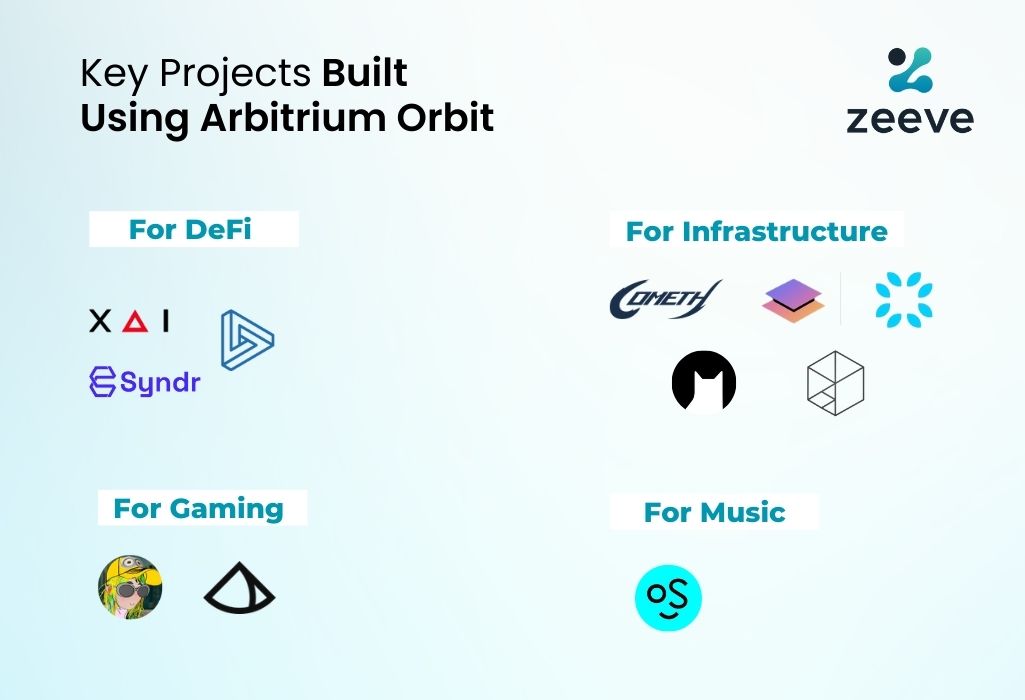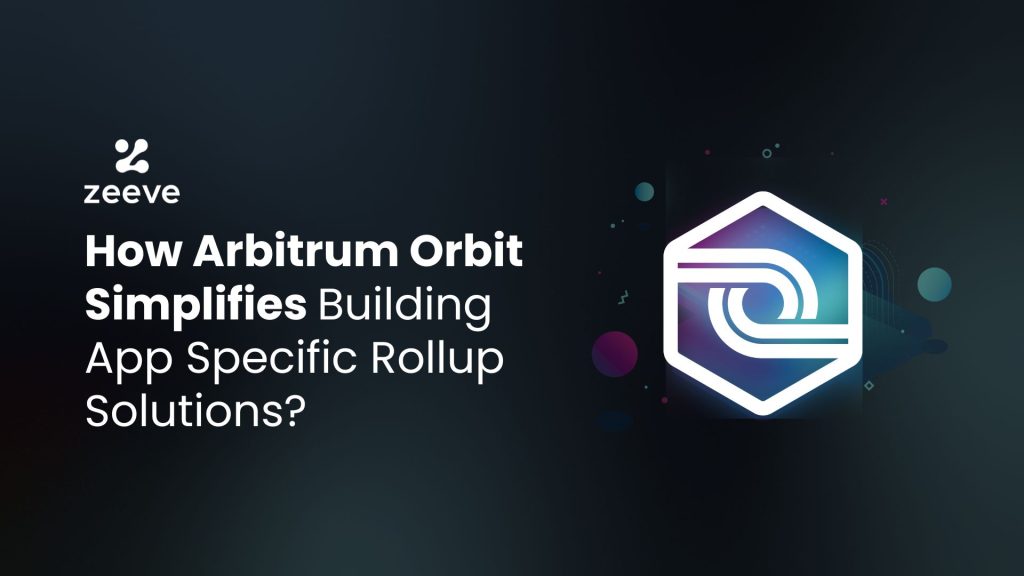Based on 2023’s dApp industry report, Arbitrum Orbit has stood out as a framework, seeing chains with the highest user growth. Each of its chains has recorded an approximately 600% increase in wallet users year after year. Speaking of innovation, a lot of next-gen projects have been building their L3 Orbit chain in various niches, spanning web3 gaming, DeFi, socialFi, and asset tokenization. In this article, we will delve deeper to understand what Arbitrum Orbit is doing to set a completely different narrative for app-specific rollups in 2024 & beyond.
What is Arbitrum Orbit?
Arbitrum Orbit, is an advanced, permissionless, and modular rollup framework for launching dedicated L2 and L3 chains according to suit business specific use-cases. This helps distinct we3b projects to create their standalone chains without compromising security, as the Orbit chain inherits robust security from the underlying main chain. From TPS, gas token, privacy, to governance, precompiles, and data availability layer– Arbitrum Orbit chains have the flexibility to add personalization to each aspect of their chain.
Applications running on top of Arbitrum Orbit can decentralize its ownership, governance, validation, as well as other dependencies. Additionally, Orbit chains enjoy fully functional fraud -proof, advanced compression and EVM compatibility powered through Arbitrum Nitro tech stack.
What Problem Arbitrum Orbit Solves?
Fraud Proof Validation
DApps aspire for mass level adoption in the blockchain space but in order to do that, applications have to abide by the rule set by the base layer. For example, they will have to use the same programming language which is compatible with the base layer to enjoy its decentralization and security. However, the problem is that if they wish to do that, they will have to compromise on flexibility of throughput/scalability, privacy, or gas token, and governance.
Arbitrum Orbit eliminates this problem with its Stylus EVM upgrad that allow developers to write contracts in their own programming language like Rust, C, C++, and many others. For the purpose of proof generation, the Stylus EVM uses a second Virtual Machines Execution WASM, instead of the EVM bytecodes. This makes proof generation and validation faster and cheaper in comparison to an EVM proof generation.
And post the introduction of the Nitro Upgrade, it is now possible to compile down any language which are within the ambit of the Stylus to create verifiable fraud proofs because whenever any dispute happens on the Arbitrum chain, Nitro will replay the execution of the chains in the WASM and it will be the onus of the honest Arbitrum validators to bisect all the transactions and trace the single unidentified transaction. Thereafter, they will check on-chain via a one step proof. Hence, through the use of Nitro, arbitrary WASM fraud proof validation is possible, which is not just faster but cheaper at the same time to scale the ecosystem.
Security, Composability and Customization
Arbitrum Orbit allows rollups to use off-chain DA layers like Celestia or Near DA to keep data on a separate layer rather than settling the data on-chain with Arbitrum One, Arbitrum Nova, or Ethereum Mainnet as per the need of the project. Introduction of the AnyTrust protocols provides complete customization from the standpoint of privacy, gas token, and governance to suit the specific need of the project without compromising the security because the Arbitrum Orbit chains inherit the security from the L1 Ethereum chain.
Distinct Sequencing Approach
Arbitrum Orbit uses deterministic sequencing in which the Nitro will take the source code of the sequencing once and it will compile the same twice, one for the native rollup state and the other for the WASM used for proving. The trade-off of such a practice is that the sequencer sets will only consider valid sequencing transactions and eliminate invalid ones. Thereby, saving the time and keeping- the fees low because any spam transactions will not be considered in the first place because the ecosystem uses hierarchical deterministic sequencing execution.
Flexibility in Governance
As we know, the core idea of Arbitrum Orbit revolves around personalization, which equally reflects in governance. Hence, Orbit chains have the flexibility to design their custom governance protocol or they can use Arbitrum DAO to operate as Arbitrum’s DAO-governed chains. The first option allows Orbit chains to keep decision-making authority with themselves whereas the second option transfers the authority to the Arbitrum DAO.
The Operational Model of Arbitrum Orbit
Arbitrum Orbit uses the following technology architecture to help you build the rollup of your choice as per your specific use-cases;
Arbitrum Rollup
Arbitrum Rollups settles on Arbitrum One, the public chain. It sends proofs to Ethereum for better decentralization. Through this Arbitrum Rollup chain, an application can do various things on Ethereum base layer like use Web 3 apps and deploy smart-contracts. But the only key difference will be that on Arbitrum rollup, the transactions will be 5x to 10x cheaper than what you experience on an ETH L1. However, the only downside of this practice is that when you are using the Arbitrum Rollup, though you get the scalability but it is not in tune with infinite scalability that you might need for some of your application because the posting of the fraud proof is on L1, which might significantly increase the transaction cost when compared to AnyTrust Chains.
Arbitrum AnyTrust
For AnyTrust you settle on Arbitrum Nova, another public chain of Arbitrum. With the help of the AnyTrust Chain, the reliability of data posting shifts to a DAC instead of the L1 chain. In this DAC, there are N number of members, and as long as N-1 members remain honest, the chain will function. As a result, the network is always secure before the participants who act as the members are unknown to each other and for a network attack to happen, it should build a syndicate of partners to corrupt the network.
Nitro stack
In the erstwhile set-up of Arbitrum, which was Arbitrum Classic, a custom virtual machine was in place which was in equivalence with the EVM. Hence, other programming languages could operate on top of the ARBOS or Arbitrum Virtual Machine. But post the introduction of the Nitro Core, now the Arbitrum AVM uses WASM instead of AVM and now it is possible to compile Go with WASM and this has significantly increased the proximity of operation across a wide range of languages.
What all things Arbitrum Orbit offers for App-specific rollupS?
Dedicated Throughput
High-traction dApps like gaming applications often require very high throughput and lower gas fees or near zero fees. With the help of the Arbitrum Orbit, you can very well achieve the same because in the Arbitrum Rollup ecosystem, you will have a dedicated computational resource earmarked for your own application which will significantly impact the throughput. Achieving such dedicated throughput is a challenge in a traditional rollup environment because there will be competition for the sequencer sets and computation which also might affect the UX of your application.
Greater Compatibility
While developing applications, one of the greatest drawbacks is whether your application will be EVM compatible or not. Because, in case, if it is not EVM compatible, it would build walled gardens around your application. Arbitrum Orbit resolves this through the introduction of Stylus. With the help of Stylus, you can deploy EVM turing smart-contracts using Solidity, RUST and C++. For the first time, the enterprise applications need not have to migrate to a new language or a toolchain to develop their rollup solution for their application or use-cases.
Gas Price Reliability
The problem of launching your application on a shared rollup ecosystem is getting disturbed by noisy neighbors. However, such an equation changes when you have Arbitrum Orbit to help you. Arbitrum Orbit isolates your application from the L2 chain and Ethereum, as a result, other network activity doesn’t affect the gas prices on your ecosystem and your users can continuously enjoy a standard gas pricing motivating them to stick to the ecosystem for long.
Permissioned Access
Dapps need the freedom to choose between whether to keep the information private for all or make it public. Through Arbitrum Orbit, these applications can have the discretion of either keeping the contracts open or permissionless or they can choose to keep them private as per their project requirements.
Security
Security is the crux of everything when you are hosting a whole new ecosystem on your Dapp. Through Arbitrum Orbit, your application inherits the security of the Arbitrum L2 chain because all the transactions are settled on the Arbitrum L2, which inherits the security of the base Ethereum chain.
Main Use cases of Arbitrum Orbit
Web3 Gaming
Arbitrum Orbit has been used to build the popular XAI blockchain that accommodates the need for Web 3 gaming which require specific dedicated throughput and scalability to support a sustainable ecosystem.
NFT Marketplaces
For the NFT market to scale, it must provide near zero gas fee advantage and various customizations. The Rari chain developed using the Arbitrum Orbit Stack provides exceptional speed to the NFT marketplace for sustaining the next generation of NFT adoption.
DeFi
Arbitrum Orbit is also helping DeFi scale with custom gas tokens to help DeFi Dapps scale. Kinto is the latest addition on the Arbitrum Orbit’s cap which is helping support both financial institutions and decentralized protocols to interconnect and communicate with each other for the next level of DeCeFi adoption.
Key Projects Built Using Arbitrum Orbit
Read in-depth about the top Arbitrum Orbit projects from our dedicated article linked here: What’s brewing on Arbitrum Orbit? Navigating the Hottest Projects.
And, here’s a brief overview of key projects:

How Zeeve Can simplify Launch of your Arbitrum Orbit Chains?
Zeeve has expanded its RaaS offerings and now offers Arbitrum Orbit Compatibility. Developers can build their custom tailored Orbit chains with Custom DA, custom VM, custom gas token, custom privacy, custom governance and everything with the enterprise-grade Zeeve RaaS platform.
Our range of integration partners also augment the power of your Arbitrum Rollups with additional functionalities including Alt Data Availability, Sequencers, decentralized oracles, account abstraction SDks and other tools. All these are available as a pluggable component through the Zeeve Rollups-as-a-service platform. Also, you set up a fully-functional Arbit Orbit DevNet to test drive your chain before testnet/mainnet launch.
Apart from these you get full provisioning (Block explorers, faucets, data indexers, bridges etc) along with enterprise SLA and 99.9% uptime guarantee.
If you are planning to launch your own rollups, feel free to reach out to us. Our experts can help you identify the best infrastructure suitable for your use case. Schedule a call today!






















